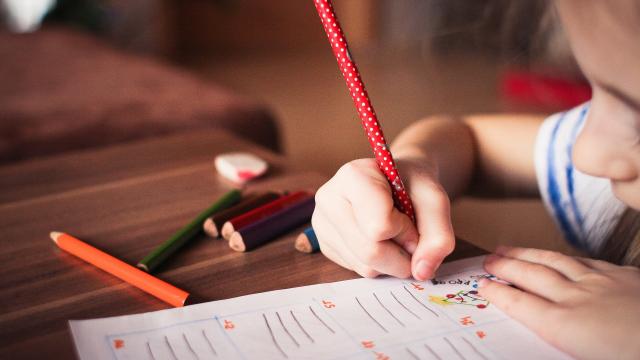There’s a common misconception about dyslexia – that it involves “backward reading” or “mirror reading”. Reversing letters isn’t always a sign of dyslexia, and a lot of little kids who don’t have the disorder write their letters backwards, too.
Instead, dyslexia is an “unexpected difficulty in reading for an individual who has the intelligence to be a much better reader,” according to the Yale Center for Dyslexia & Creativity.
Those with dyslexia have trouble matching the letters they see on a page to the sounds those letters make. It’s one of the most common learning-based language disabilities, and yet you may not know your child has it.
Dr Meghan L. Jorgenson, a Clinical Neuropsychologist at The Child Study Center in Hassenfeld Children’s Hospital at NYU Langone, tells us some of the most common signs you should pay attention to.
How Do You Get Dyslexia?
According to Dr Jorgenson, dyslexia can occur spontaneously, but it isn’t uncommon for a child with a learning disorder to have a family member who also has it.
It’s important to know that dyslexia isn’t an indicator of intelligence, or lack thereof – some of the brightest kids struggle to read.
“It’s more of a specific weakness in a certain skill,” Dr Jorgenson says.
In those with the disorder, the back part of the brain between the occipital and temporal lobes is affected, Dr Jorgenson explains. Normally, an individual without the disability will process information very quickly and efficiently. In kids with dyslexia, however, this processing doesn’t work as well.
“[That part of the brain] is not as activated, since they have overactivation in the frontal parts of the brain,” she says.
[referenced url=”https://www.lifehacker.com.au/2018/04/stop-labelling-kids-by-their-learning-style/” thumb=”https://i.kinja-img.com/gawker-media/image/upload/t_ku-large/urtzltsmh7kka2iarqez.jpg” title=”Stop Labelling Kids By Their ‘Learning Style’” excerpt=”You may have taken the quiz as a child. What type of learner are you? You’d answer questions such as, ‘When you see the word cat, are you more likely to a) picture a cat in your head, b) say the word ‘cat’ to yourself, or c) imagine yourself physically petting a cat?’ Once you made your selections, your so-called learning style would be revealed. Congrats! You’re a visual, auditory or kinesthetic learner!”]
At What Age Does It Become Apparent?
Your child could be diagnosed as early as Year 1 or 2.
What Are Some Signs of Dyslexia?
Here are some examples of the first early signs:
- Struggling with the alphabet
- Pronouncing words
- Recognising rhyming
If you have concerns, first, make sure your child was giving adequate instructions in the subject.
“We want to make sure they were given formal instructions in full, but they still struggle to acquire those academic skills at the same rate as their peers,” says Dr Jorgenson.
Kids who are struggling academically might try to avoid tasks they aren’t succeeding at – for instance, they don’t want to sit down and read. Often, children with symptoms of dyslexia read more slowly if they can’t pick up on certain sounds. While some kids will have a milder version of dyslexia, others can have more severe symptoms.
[referenced url=”https://www.lifehacker.com.au/2018/01/help-kids-learn-by-focusing-on-the-wrong-answers/” thumb=”https://i.kinja-img.com/gawker-media/image/upload/t_ku-large/i2uwoenlyyjs9m6ykgx5.jpg” title=”Help Kids Learn By Focusing On The Wrong Answers” excerpt=”A typical lesson in a Western classroom might look something like this: ‘What’s the most common gas in Earth’s atmosphere?’ the teacher asks. Kids raise their hands.”]
What Can You Do to Help a Kid With Dyslexia?
Get an evaluation, as early as possible, based on their symptoms. Children with dyslexia need individualised support and would have to qualify for an Individual Education Plan (IEP).
Dr Jorgenson recommends that a child with dyslexia follow a multi-sensory instruction approach, which is a letter/sound relationship technique to improve reading skills.
She emphasises the importance of individualised support because it allows instruction to be slowed down to a student’s level so they get the support they need.
How Can You Be Supportive?
It can be tough to know how to handle an unfamiliar situation such as dyslexia.
If your children struggle in school, Dr Jorgenson says it’s important you recognise that it can impact their self-esteem. Provide opportunities for them to engage in activities they enjoy – art, music or theatre, perhaps – allowing them to nurture their strengths.
When it comes to books, let them read what they’re interested in (comic books included!) in a zero-pressure environment.
Also, talk to your kid’s teacher or principal about any concerns you might have – they may be able to provide accommodations such as extra time on tests. (And know that if your student qualifies for an IEP and the IEP recommends accommodations, the school must provide them.)
Will It Improve Over Time?
While there’s no “cure”, people with dyslexia can make great progress and become highly successful. Dr Jorgenson notes that this doesn’t mean the challenges will go away.
She recommends seeking intervention early on for this reason: The gap between kids struggling in an area in which they’re not making progress at the same rate as their peers can get bigger. But with the right support, they will be able to reach their full potential in their own time.

Comments